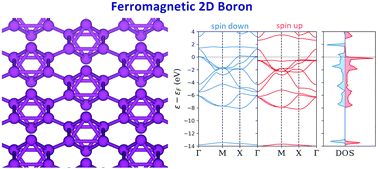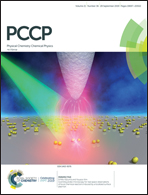Superoctahedral two-dimensional metallic boron with peculiar magnetic properties†
Abstract
Among the diversity of new materials, two-dimensional crystal structures have been attracting significant attention from the broad scientific community due to their promising applications in nanoscience. In this study we predict a novel two-dimensional ferromagnetic boron material, which has been exhaustively studied with DFT methods. The relaxed structure of the 2D-B6 monolayer consists of slightly flattened octahedral units connected with 2c-2e B–B σ-bonds. The calculated phonon spectrum and ab initio molecular dynamics simulations reveal the thermal and dynamical stability of the designed material. The calculation of the mechanical properties indicate a relatively high Young's modulus of 149 N m−1. Moreover, the electronic structure indicates the metallic nature of the 2D-B6 sheets, whereas the magnetic moment per unit cell is found to be 1.59 μB. The magnetism in the 2D-B6 monolayer can be described by the presence of two unpaired delocalized bonding elements inside every distorted octahedron. Interestingly, the nature of the magnetism does not lie in the presence of half-occupied atomic orbitals, as was shown for previously studied magnetic materials based on boron. We hope that our predictions will provide promising new ideas for the further fabrication of boron-based two-dimensional magnetic materials.

- This article is part of the themed collection: 2019 PCCP HOT Articles


 Please wait while we load your content...
Please wait while we load your content...